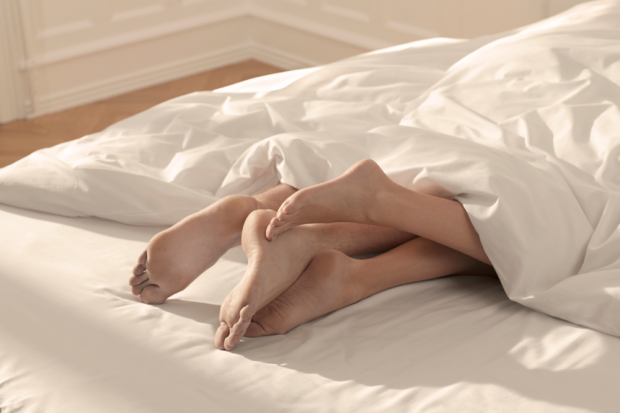Love Notes How Touching Feet While Sleeping Can Improve Your Relationship
If you and your partner’s sleeping position includes playing footsie, you’re in luck. Foot cuddling while snoozing is a sign of a pretty awesome relationship.
Holding hands is SO yesterday.
According to several recent studies, the latest sign of a healthy, loving relationship is touching feet — otherwise known as foot cuddling — while you and your partner are in bed.
The theory is that because you and your lover’s subconscious minds control the way you sleep together, the resulting “sleep body language” can be an incredibly accurate way to assess the state of your relationship, maybe even more so than examining something like your sex life.
"During sleep, you cannot fake your body language. This is the time when you are honest, vulnerable and your sleeping position can reveal a lot about your relationship,” explains couple’s psychologist and self-help author Corrine Sweet.
And apparently, the feet are a very important element when it comes to what your usual snuggle and sleeping position says about your bond.
Feet First
“Being far from the brain and the first part of your body to react in the case or a flight or flight response, the feet are the most honest portion of the body, under the least conscious control,” shares Patti Wood, a body language expert and author of Success Signals, A Guide to Reading Body Language.
When partners assume a sleeping position in which their feet are touching, it’s a serious sign of trust. Body language experts agree that one of the greatest tests of intimacy is being both physically and emotionally comfortable with your spouse or partner touching your tootsies. It’s generally one of the last places romantic partners permit each other to touch (outside of foot massages, of course).
RELATED: The Strange Things Your Feet Can Tell You About Your Relationship
In fact, Wood asserts that falling asleep while touching toes is usually reserved for long-term coupledom. “[The] position may be assumed after years of marriage when the couple wants space but still wants to connect,” she says on her official website. “Alternatively, it’s a position couples take after a fight when they would normally have slept closer but since they’re angry they don’t go to the old position. Instead they signal ‘I will still love each you in the morning’ by touching the feet or legs... I love that your mind is mad but your body says, ‘I still love you and I won’t kick you out of the bed.’”
READ ALSO: How Do I Tell My Partner I Have A Foot Fetish?
Countless studies suggest that couples who foot cuddle are very connected but display a healthy amount of independence. In fact, according to research done by sleep specialist Chris Idzikowski, sleeping with the bottoms of your feet touching indicates a strong bond where the couple is free to express their individuality.
Tootsie Troubles
However, not all foot cuddling is roses and rainbows. Wood suggests that if your partner doesn’t usually touch your feet while he or she is asleep but suddenly starts, it could be a sign that he or she is craving an emotional or sexual connection not currently present. Conversely, body language studies show that when the feet begin to drift apart, it could be a signal of a rift in the relationship that needs repair.
READ ALSO: Ultra Sexy At-Home Spa Treatments For Couples
But don’t worry if you and your partner rarely touch toes while sleeping, as it’s not a cause for concern. Several other sleeping positions — including spooning, hugging, lying arm in arm, and being completely intertwined — also signify a healthy relationship. What’s important is that you feel toe’riffic together, whether you engage in a little foot cuddling or not.
Notice concerning medical entries:
Articles having medical content shall serve exclusively for the purpose of general information. Such articles are not suitable for any (self-) diagnosis and treatment of individual illnesses and medical indications. In particular, they cannot substitute for the examination, advice, or treatment by a licensed physician or pharmacist. No replies to any individual questions shall be effected through the articles.






